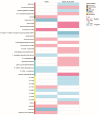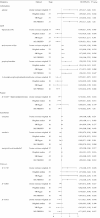Mendelian randomization analysis reveals causal associations of serum metabolites with sepsis and 28-day mortality
- PMID: 38773119
- PMCID: PMC11109149
- DOI: 10.1038/s41598-024-58160-1
Mendelian randomization analysis reveals causal associations of serum metabolites with sepsis and 28-day mortality
Abstract
Metabolic disorder has been found to be an important factor in the pathogenesis and progression of sepsis. However, the causation of such an association between serum metabolites and sepsis has not been established. We conducted a two-sample Mendelian randomization (MR) study. A genome-wide association study of 486 human serum metabolites was used as the exposure, whereas sepsis and sepsis mortality within 28 days were set as the outcomes. In MR analysis, 6 serum metabolites were identified to be associated with an increased risk of sepsis, and 6 serum metabolites were found to be related to a reduced risk of sepsis. Furthermore, there were 9 metabolites positively associated with sepsis-related mortality, and 8 metabolites were negatively correlated with sepsis mortality. In addition, "glycolysis/gluconeogenesis" (p = 0.001), and "pyruvate metabolism" (p = 0.042) two metabolic pathways were associated with the incidence of sepsis. This MR study suggested that serum metabolites played significant roles in the pathogenesis of sepsis, which may provide helpful biomarkers for early disease diagnosis, therapeutic interventions, and prognostic assessments for sepsis.
© 2024. The Author(s).
Conflict of interest statement
The authors declare no competing interests.
Figures




Similar articles
-
Causal insights into the role of metabolites in venous thromboembolism pathogenesis: a metabolome-wide Mendelian randomization study.J Thromb Haemost. 2025 Jun;23(6):1953-1967. doi: 10.1016/j.jtha.2025.03.022. Epub 2025 Mar 27. J Thromb Haemost. 2025. PMID: 40157505
-
Non-targeted metabolomics revealed novel links between serum metabolites and primary ovarian insufficiency: a Mendelian randomization study.Front Endocrinol (Lausanne). 2024 Apr 26;15:1307944. doi: 10.3389/fendo.2024.1307944. eCollection 2024. Front Endocrinol (Lausanne). 2024. PMID: 38737546 Free PMC article.
-
Causal associations of gut microbiota and metabolites on sepsis: a two-sample Mendelian randomization study.Front Immunol. 2023 Sep 14;14:1190230. doi: 10.3389/fimmu.2023.1190230. eCollection 2023. Front Immunol. 2023. PMID: 37781358 Free PMC article.
-
Unraveling the Causal Relationship Between Blood Metabolites and Acne: A Metabolomic Mendelian Randomization Study.J Cosmet Dermatol. 2025 Jan;24(1):e16763. doi: 10.1111/jocd.16763. J Cosmet Dermatol. 2025. PMID: 39737744 Free PMC article.
-
Causal relationship between blood metabolites and risk of five infections: a Mendelian randomization study.BMC Infect Dis. 2023 Oct 7;23(1):663. doi: 10.1186/s12879-023-08662-6. BMC Infect Dis. 2023. PMID: 37805474 Free PMC article.
Cited by
-
Physical activity, sedentary behavior, and risk of sepsis: a two-sample mendelian randomization study.Front Med (Lausanne). 2024 Aug 19;11:1436546. doi: 10.3389/fmed.2024.1436546. eCollection 2024. Front Med (Lausanne). 2024. PMID: 39224605 Free PMC article.
-
Pneumonia-specific plasma metabolite profiles among patients hospitalised with infection in Southeast Asia.ERJ Open Res. 2025 May 27;11(3):00582-2024. doi: 10.1183/23120541.00582-2024. eCollection 2025 May. ERJ Open Res. 2025. PMID: 40432817 Free PMC article.
-
Fibulin2 is a good diagnostic and prognostic indicator for sepsis.BMC Infect Dis. 2025 Aug 13;25(1):1015. doi: 10.1186/s12879-025-11282-x. BMC Infect Dis. 2025. PMID: 40804663 Free PMC article.
References
MeSH terms
LinkOut - more resources
Full Text Sources
Medical

